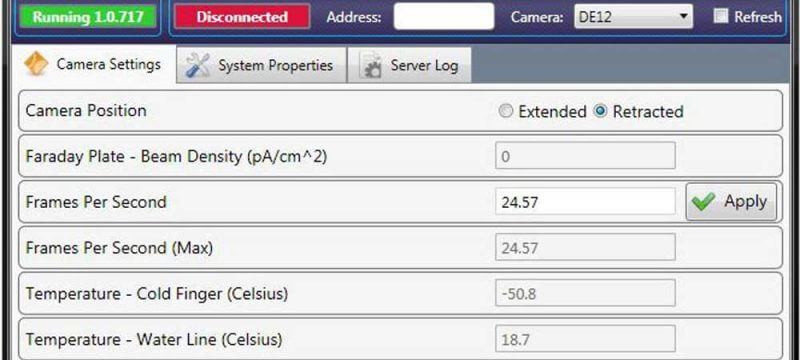The DE-12 was the first commercially available direct detector for electron microscopy. With 4096 x 3072 pixels and a frame rate of 40 fps at full frame, the DE-12 was initially used for single-particle Cryo-EM. Later, pioneering in situ TEM studies into materials such as batteries were performed using a DE-12.
The DE-12 has now been superseded by the Apollo camera. With it’s unique event-based hardware electron counting capabilities, Apollo offers the ability to perform the same type of Cryo-EM and in situ TEM experiments as the DE-12, with faster throughput and higher signal to noise.
The DE-DirectView was an updated version of our DE-12 camera. The DirectView was a camera that enabled researchers to upgrade older but capable electron microscopes with a direct detector, greatly enhancing the capabilities of the microscope.
The DE-DirectView has now been superseded by the more advanced DirectView2 camera. With a larger pixel pitch, larger total number of pixels, and faster frame rates, the DirectView2 is a more powerful option for those seeking to add direct detection capabilities to their existing electron microscope.
The DE-20 was a 5120 x 3840 pixel direct detector designed primarily for single-particle Cryo-EM and Cryo Electron Tomography applications. The DE-20 was capable of 32 frames per second (fps) readout speeds at full frame, and over 500 fps readout with a small windowed area.
The DE-20 has now been superseded by the Apollo camera. With it’s unique event-based hardware electron counting capabilities, Apollo offers the ability to perform the same experiments as the DE-20, and more, with faster throughput and higher signal to noise.
The LV-126 detector was our first monolithic active pixel sensor designed to operate at lower electron beam voltages (10-40 kV) more typically used in applications such as low energy electron microscopy (LEEM) or photoemission electron microscopy (PEEM). The detector featured 4096 x 3072 pixels and a frame rate of 40 fps at full frame.
The LV-126 has now been superseded by our LV-16 camera. The LV-16 offers a number of advantages compared to the LV-126, including a larger 4096 x 4096 pixel array, faster readout speeds of up to 92 fps at full frame size, and an exceptionally uniform response across the field of view.
Early in Direct Electron’s history, we offered high performance lens coupled and fiber coupled CCD cameras, such as the LC-1100, the FC-400, and the FC-1600. Ultimately, as our Direct Detectors demonstrated superior detective quantum efficiency and signal to noise, these CCDs were superseded by our DE-Series detectors, such as the DE-16, DE-16ER, and DE-64.

To maximize flexibility, this legacy software for our cameras allows for a client-server model. Our DE-Server software, running on the dedicated camera PC, directly controls the camera hardware. A variety of clients either on the local or a networked computer could connect to the DE-Server and issue commands to control the camera and acquire images. We still offer a software development kit, including documentation and many examples to make it easy to fully integrate our cameras in nearly any software, including C#, C++, Python, and others.
DE-Server has been superseded by Mission Control.

DE-StreamPix has been our recommended software for in situ TEM, 4D STEM, and other applications involving acquisition of continuous large datasets. DE-StreamPix featured unlimited data streaming up to the maximum frame rate of the camera, real-time viewing of frames during data acquisition, and post-triggering (also known as a "look-back feature") for accurate event capturing. Our DE-Player software allowed data acquired with Streampix to be exported to a variety of standard open file formats for ease of use in research.
DE-Streampix has been superseded by Mission Control, and by Dimension for 4D STEM.

DE Imaging Manager (DE-IM) is legacy software for typical HRTEM data collection. DE-IM featured a modern and intuitive user interface to maximize ease-of-use and data collection efficiency. It allowed users to automatically and seamlessly take advantage of the full features of Direct Electron cameras, such as the ability to perform electron counting, and to integrate metadata from the microscope and the camera with each acquired image. DE-IM was developed in partnership with AppFive.
DE-IM has been superseded by Mission Control.
Dive deeper with a carefully curated list of journal articles! Search by Application, Technique, Impact and more!